Abstract
We describe in this article the current development status of virtual reality (VR) technology and its application prospects in education, and we describe the design and implementation process for a hybrid online and offline teaching system. This system utilizes VR devices and software to bring students into a virtual learning environment, to interact with virtual objects, and to perform practical operations. At the same time, the system provides online courses, learning resources, and social platforms to promote cooperation and communication among students. Compared with traditional teaching, this online and offline hybrid teaching system significantly improves students’ learning interest and induces active participation. Students have positive experiences of using VR technology for learning and believe that the system provides rich and practical learning resources.
1. Introduction
The application of virtual reality (VR) technology in teaching has been developing rapidly [1]. In teaching, VR technology has been widely applied in teaching English. By creating a simulated three-dimensional environment, VR technology enables students to gain experience and participate in the learning process [2] as shown in Figure 1. In English learning, VR technology provides an immersive language environment, enabling students to engage in dialogue and communication with virtual characters, thereby enhancing their oral expression and listening comprehension abilities [3,4].
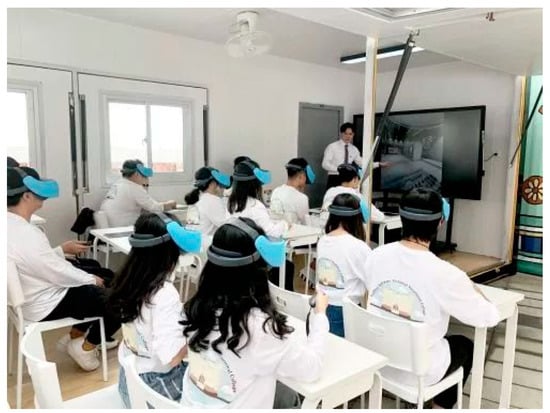
Figure 1.
Example of a VR classroom.
VR technology can also be applied to English courses, in which students can experience cultural backgrounds through virtual travel and scene representation, thereby enhancing their memory and understanding of the English language [5,6]. Although VR technology has broad application prospects in teaching, it still faces challenges. Firstly, the high cost of VR devices limits their promotion in schools and educational institutions [7]. Secondly, teachers need to receive relevant training to effectively apply VR technology to teaching. The application of VR technology in teaching is actively advancing [8]. With the advancement of technology and the reduction of costs, the wider application of VR in education is expected, thereby providing students with a more diverse learning experience.
2. Design of Online and Offline Hybrid Teaching System Based on VR
2.1. System Design
A VR-based teaching platform system architecture is designed to provide a VR educational experience. The system combines VR technology and teaching methods to create an immersive and interactive learning environment for students. The core components of this system include hardware devices, software applications, and content resources. Hardware devices include VR headsets, joystick controllers, and other devices to place users in the virtual world and interact with its elements. The software is responsible for managing the entire system’s operation and providing various functional modules such as course management and user authentication. The content is educational and is created by developers or teachers and uploaded to the platform as shown in Figure 2.
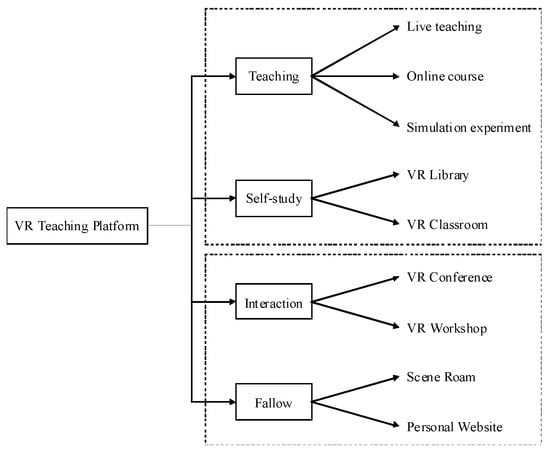
Figure 2.
System architecture of the VR system.
2.2. Interactive Design in VR Teaching
VR technology has the potential to revolutionize the learning environment by providing learners with interactive modes that transcend the limitations of traditional teaching methods. Through the design of interaction-based tasks and feedback, interactive tasks and indirect metaphors effectively improve the user experiences of learners’ by utilizing VR devices. The direct-metaphor design is associated with learners’ existing experience levels so that learners can understand and master the task requirements quickly. For example, in education, direct metaphors can be used to transform mathematical problems into concrete object operations, thus allowing students to solve problems by touching, rotating, and so on. Indirect metaphor design guides learners to think and infer using suggestions or analogies and stimulates them to actively participate in the interaction process. This design increases interest and attraction and cultivates learners’ independent thinking and creative thinking. For example, in language learning, indirect metaphors were used to help students understand abstract concepts or complex sentence structures (Table 1).

Table 1.
Interaction mode of VR teaching.
Another important benefit of this approach to interactive task design is the reduction of additional cognitive load. As VR equipment requires high attention concentration and spatial perception ability, if there are complicated or non-logical operation instructions in the process of task execution, then it brings additional loads to users and reduces their understanding of task objectives and feedback information. Therefore, the interaction design must be created so as to avoid introducing too many irrelevant factors and to ensure that the instructions are concise and easy to understand. In summary, interactive tasks based on direct and indirect metaphor design are feasible on VR devices and enable the smooth, enjoyable, and efficient completion of tasks.
2.3. Hardware of VR Teaching System
The hardware of the VR teaching system includes equipment and components to support VR teaching (Figure 3).
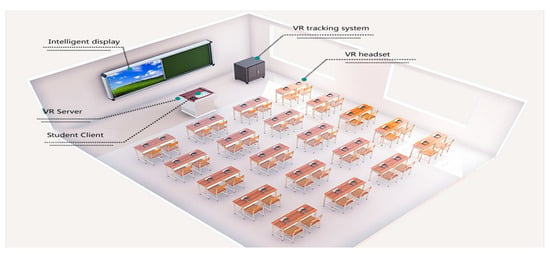
Figure 3.
Hardware architecture of VR teaching.
- VR headset: The VR headset is one of the core devices in VR teaching. It consists of a wearable device that is used to present VR content to the user’s vision system. VR headsets typically include components such as high-resolution displays, sensors, and lenses to provide a realistic VR experience.
- Tracking systems: Tracking systems are used to track a user’s location and movements in a VR environment. These devices include external cameras, infrared sensors, gyroscopes, and laser trackers. Through the tracking system, teachers can understand the status of students in the virtual environment and give corresponding guidance.
- Controller: The controller is the device through which the user interacts with the virtual environment. Controllers usually contain control elements such as buttons, joysticks, and triggers that simulate the user’s hand movements or other operations. The controller allows students to perform various operations in a virtual environment, such as making selections, drawing, and operating virtual instruments.
- Computing equipment: VR teaching requires powerful computing equipment that can handle a large number of graphics and computing tasks. These devices can be high-performance desktop computers, game consoles, or specialized VR all-in-one machines. Computing devices are responsible for rendering virtual environments in real time and transmitting them into VR headsets to deliver a smooth VR experience.
- Interactive devices: In addition to controllers, VR teaching is realized with interactive devices such as gloves, motion-sensing devices, and haptic feedback devices to enhance the user’s interactive experience with the virtual environment. These devices allow students to more intuitively feel the objects and actions in the virtual environment, further improving the teaching effect.
2.4. Three-Dimensional Modeling
The VR virtual experiment platform uses 3Dmax as a 3D engine, which has powerful functions and flexibility. By using 3Dmax, users can easily build a variety of parameters that match the physical object to create a realistic virtual scene. On the virtual experimental platform, users can carry out three-dimensional construction and mapping of objects. With simple steps, users can place objects of different shapes, sizes, and materials into a scene and adjust and position them. At the same time, elements are removed or added to improve the scene. In addition to the basic functions, the platform provides a variety of additional operational options. For example, in the model editing process, users can delete certain parts to achieve a specific effect; additional elements can also be added to enhance scene expressiveness. This flexibility allows users to create according to their needs as beginners or professionals.
The use of 3Dmax as a 3D engine on a VR virtual experiment platform allows for convenience and a range of possibilities. It is used to build parameters that meet the requirements of physical objects and provide a variety of operation options to meet the needs of users for three-dimensional construction, mapping, and other aspects. This makes the platform an ideal tool for applications in education, design, entertainment, and other fields. Designs of a student’s perspective and a teacher’s perspective is shown in Figure 4 and Figure 5.
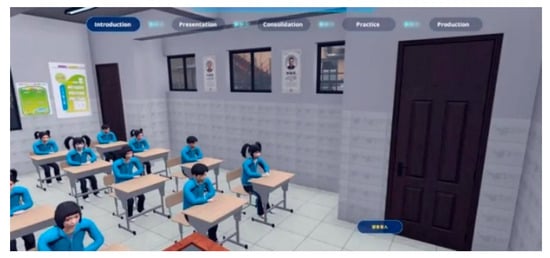
Figure 4.
Student perspective in VR model.
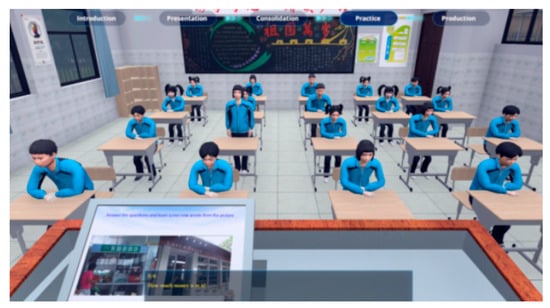
Figure 5.
Teacher’s perspective.
2.5. VR Teaching Scene
In VR teaching, VR technology is used to simulate a real teaching environment. Students wear specially designed VR headsets, enter a completely virtual environment, and learn in an immersive way. In VR teaching, a variety of real learning scenes such as historical scenes, science laboratories, and art exhibitions can be created. Students interact with objects in a virtual environment, observe details, experience hands-on operation, and receive immediate feedback and guidance. For example, in history lessons, students can experience historical events through VR teaching scenes, such as visiting ancient buildings and participating in major battles. They can move freely through virtual scenes, observe details, engage in conversations with historical figures, and learn about historical interpretations from different perspectives. This immersive learning style stimulates students’ interest and improves their learning results. In science education, VR teaching scenarios are created to simulate a science laboratory’s environment, including allowing students to conduct various experiments. Students can operate the virtual experimental equipment, observe the experimental results, and conduct experimental analysis with the guidance of a virtual tutor. This hands-on approach to learning develops students’ experimental skills and scientific thinking. In addition, a new experience in art education can be obtained in VR teaching scenes. Students can visit the art exhibition hall, appreciate famous paintings, and understand the creative inspiration and skills of artists. They can also use VR tools for artistic creation, such as painting and sculpture, to cultivate their aesthetic ability and creativity. VR teaching scenarios provide an innovative way of delivering education to help students learn in an immersive way. It can broaden students’ learning horizons, stimulate their learning interests, and promote the development of creative thinking. By combining virtual environments and reality, VR teaching scenarios will become an important part of education in the future.
3. Conclusions
This online and offline hybrid teaching system based on VR has significant advantages. The system overcomes the time and space limitations of the traditional teaching mode and provides students with an immersive learning experience. Students can participate in various simulation experiments, scene drills, and situational interactions through VR technology and enhance their sense of reality and participation in learning. At the same time, the online and offline hybrid teaching system can overcome the problems of human resources, material conditions, and time limitations faced by traditional offline classroom teaching, thus providing students with a more flexible and personalized learning mode. Secondly, the online and offline hybrid teaching system can effectively promote students’ learning effectiveness. VR technology provides students with a new learning mode by stimulating students’ learning interests and initiatives. Through virtual experiments, scene simulation, and interactive experiences, students can explore abstract concepts and gain knowledge to improve learning effectiveness. In addition, the online and offline hybrid teaching system can be used to adjust teaching strategies promptly through data analysis and feedback and enable the personalized tutoring of students to improve learning effectiveness. Thirdly, the online and offline hybrid teaching system based on VR faces challenges in application. Technical limitations may affect the stability and practicality of the system. The cost of system construction and maintenance is high, requiring sufficient investment and support. In addition, for non-technical disciplines, the application of VR technology may be subject to certain limitations. Therefore, in the promotion and application process, education resources, technical conditions, subject characteristics, and other factors need to be considered comprehensively. The online and offline hybrid teaching system based on VR has many prospects for use in education. The continuous innovation and improvement of VR technology will allow for more opportunities and challenges to be faced. By continuously optimizing the system’s functions and teaching design, student participation and learning effectiveness can be improved. The system could play a greater role in higher education.
Author Contributions
Conceptualization, H.Y. and N.N.Z.; methodology, H.Y.; software, H.Y.; validation, H.Y., N.N.Z. and N.K.; formal analysis, H.Y.; investigation, H.Y.; resources, H.Y.; data curation, H.Y.; writing—original draft preparation, H.Y.; writing—review and editing, H.Y.; visualization, H.Y.; supervision, H.Y.; project administration, H.Y.; funding acquisition, N.N.Z. All authors have read and agreed to the published version of the manuscript.
Funding
This research received no external funding.
Institutional Review Board Statement
Not applicable.
Informed Consent Statement
Informed consent was obtained from all subjects involved in the study.
Data Availability Statement
Data sharing is not applicable to this article.
Conflicts of Interest
The authors declare no conflict of interest.
References
- Żammit, J. Exploring the effectiveness of VR in teaching Maltese. Comput. Amp; Educ. X Real. 2023, 3, 100035. [Google Scholar]
- Stam, D.; Jenkins, G.M.; Goettl, H.; Martinson, J.; Fondrick, A.; Lindahl, R.; Withrow, Z. Transforming the Heart of Student Learning and Engagement: A Randomized Crossover Trial for the Novel Application of Immersive VR in Teaching Electrocardiography Interpretation. J. Acute Care Phys. Ther. 2023, 14, 181–190. [Google Scholar] [CrossRef]
- Isabel, T.; Vanessa, S.; Omar, C.; Buigues, C. Evaluating video VR teaching for nursing students. Med. Educ. 2023, 57, 1157–1158. [Google Scholar]
- David, K.; Matthias, C.; Stephan, S. Immersive VR-based instruction in vocational schools: Effects on domain-specific knowledge and wellbeing of retail trainees. Empir. Res. Vocat. Educ. Train. 2023, 15, 9. [Google Scholar]
- Kresge, C.; Justice, S.; Stanford, S.; McClerking, C. The Use of VR in Teaching Diagnostic Reasoning to Advanced Practice Registered Nurse Students. Nurse Educ. 2023, 49, 55–56. [Google Scholar] [PubMed]
- Koucheki, R.; Lex, J.R.; Morozova, A.; Ferri, D.; Hauer, T.M.; Mirzaie, S.; Ferguson, P.C.; Ballyk, B. Immersive VR and Cadaveric Bone are Equally Effective in Skeletal Anatomy Education: A Randomized Crossover Noninferiority Trial. J. Surg. Educ. 2023, 80, 1028–1038. [Google Scholar] [CrossRef] [PubMed]
- Álvaro, A.; Pablo, F.; Diego, V. Higher Education in the Pacific Alliance: Descriptive and Exploratory Analysis of the Didactic Potential of VR. Multimodal Technol. Interact. 2023, 7, 30. [Google Scholar]
- Agbo, F.J.; Olaleye, S.A.; Bower, M.; Oyelere, S.S. Examining the relationships between students’ perceptions of technology, pedagogy, and cognition: The case of immersive VR mini games to foster computational thinking in highe r education. Smart Learn. Environ. 2023, 10, 16. [Google Scholar] [CrossRef]
Disclaimer/Publisher’s Note: The statements, opinions and data contained in all publications are solely those of the individual author(s) and contributor(s) and not of MDPI and/or the editor(s). MDPI and/or the editor(s) disclaim responsibility for any injury to people or property resulting from any ideas, methods, instructions or products referred to in the content. |
© 2024 by the authors. Licensee MDPI, Basel, Switzerland. This article is an open access article distributed under the terms and conditions of the Creative Commons Attribution (CC BY) license (https://creativecommons.org/licenses/by/4.0/).